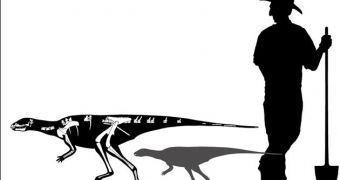Dinosaurs have fascinated everybody since their discovery, but this was mainly due to their sheer size.
In time, scientists discovered really interesting things about them: some were feathered, they were warm-blooded, they cared for their offspring, some had "hands", some flew...
Now researchers have discovered a new species of ... digging dinosaur!
The 95 million years small dinosaurs have been discovered by a team from Montana State University led by Dr David Varricchio. The bones come from an adult and two juveniles and were found in a chamber at the end of a 2.1m (7 ft)-long sediment-filled tunnel.
Obviously, this is the first evidence that some dinosaurs dug dens inside which they cared for their offspring. "Burrowing also represents a mechanism by which small dinosaurs may have exploited the extreme environments of polar latitudes, deserts and high mountain areas," explained Varricchio.
The new species was named Oryctodromeus cubicularis, "digging runner of the lair". The species' snout, shoulder girdle and pelvis present adaptations for digging. Based on the preserved vertebrae, the adults were estimated to have been about 2.1m (6.8ft) from nose to tail, with the greatest part (1.2m; 3.9ft) representing the tail.
The animal's estimated width matches neatly the diameter of the tunnel it dug (about 30cm;1ft). The tunnel is sloped and presents two sharp turns before ending in a chamber, with an architecture similar to the dens of modern burrowers, like the striped hyena or badgers.
The fossils were covered in the coarse-grained sediment brought by an ancient flood, but this flood did not kill the dinosaurs. "The bones are disarticulated; they are not in life position. It's not like they were sitting in the burrow and a flooding event filled the chamber with sediment and they were entombed. They must have died, undergone decay and then the burrow was filled", Varrichio said.
This Montana team is praised for its detailed work. "Many would have missed the significance of the tunnel. This discovery is first and foremost a testament to the value of keeping one's eyes open in the field and noticing everything, and it took a special group of scientists to realize the meaning of the discovery that they made," said Professor Kevin Padian from the Museum of Palaeontology, University of California-Berkeley.
"Commercial fossil hunting sought to get specimens out of the ground as fast as possible, often destroying valuable scientific information in the process."

 14 DAY TRIAL //
14 DAY TRIAL //